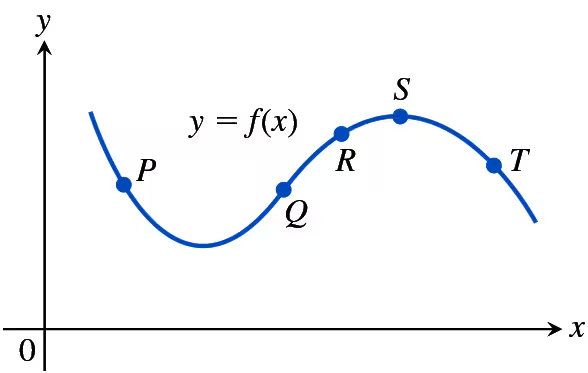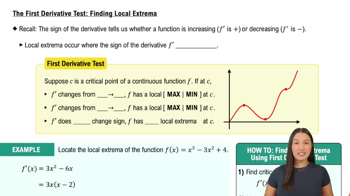Graph f(x) = x cos x and its second derivative together for 0 ≤ x ≤ 2pi. Comment on the behavior of the graph of f in relation to the signs and values of f".
Table of contents
- 0. Functions7h 54m
- Introduction to Functions16m
- Piecewise Functions10m
- Properties of Functions9m
- Common Functions1h 8m
- Transformations5m
- Combining Functions27m
- Exponent rules32m
- Exponential Functions28m
- Logarithmic Functions24m
- Properties of Logarithms36m
- Exponential & Logarithmic Equations35m
- Introduction to Trigonometric Functions38m
- Graphs of Trigonometric Functions44m
- Trigonometric Identities47m
- Inverse Trigonometric Functions48m
- 1. Limits and Continuity2h 2m
- 2. Intro to Derivatives1h 33m
- 3. Techniques of Differentiation3h 18m
- 4. Applications of Derivatives2h 38m
- 5. Graphical Applications of Derivatives6h 2m
- 6. Derivatives of Inverse, Exponential, & Logarithmic Functions2h 37m
- 7. Antiderivatives & Indefinite Integrals1h 26m
- 8. Definite Integrals4h 44m
- 9. Graphical Applications of Integrals2h 27m
- 10. Physics Applications of Integrals 3h 16m
- 11. Integrals of Inverse, Exponential, & Logarithmic Functions2h 31m
- 12. Techniques of Integration7h 41m
- 13. Intro to Differential Equations2h 55m
- 14. Sequences & Series5h 36m
- 15. Power Series2h 19m
- 16. Parametric Equations & Polar Coordinates7h 58m
5. Graphical Applications of Derivatives
Concavity
Problem 4.4.93
Textbook Question
93. The accompanying figure shows a portion of the graph of a twice-differentiable function y=f(x). At each of the five labeled points, classify y' and \y'' as positive, negative, or zero.

 Verified step by step guidance
Verified step by step guidance1
Step 1: Understand the problem. The graph represents a twice-differentiable function y = f(x). At each labeled point (P, Q, R, S, T), we need to classify the first derivative (y') and the second derivative (y'') as positive, negative, or zero based on the behavior of the graph.
Step 2: Analyze point P. At P, the graph is decreasing (sloping downward), so y' < 0. The graph is concave down (curving downward), so y'' < 0.
Step 3: Analyze point Q. At Q, the graph is at a local minimum, meaning the slope is zero (y' = 0). The graph transitions from concave down to concave up, so y'' > 0.
Step 4: Analyze point R. At R, the graph is increasing (sloping upward), so y' > 0. The graph is concave up (curving upward), so y'' > 0.
Step 5: Analyze point S. At S, the graph is at a local maximum, meaning the slope is zero (y' = 0). The graph transitions from concave up to concave down, so y'' < 0.
 Verified video answer for a similar problem:
Verified video answer for a similar problem:This video solution was recommended by our tutors as helpful for the problem above
Video duration:
2mPlay a video:
Was this helpful?
Key Concepts
Here are the essential concepts you must grasp in order to answer the question correctly.
First Derivative (y')
The first derivative of a function, y', represents the slope of the tangent line to the graph at any given point. It indicates the rate of change of the function. If y' is positive, the function is increasing; if y' is negative, the function is decreasing; and if y' is zero, the function has a horizontal tangent, indicating a potential local maximum or minimum.
Recommended video:

The First Derivative Test: Finding Local Extrema
Second Derivative (y'')
The second derivative, y'', provides information about the concavity of the function. If y'' is positive, the graph is concave up, resembling a 'U' shape, indicating that the slope of the tangent line is increasing. If y'' is negative, the graph is concave down, resembling an 'n' shape, indicating that the slope of the tangent line is decreasing. A zero value for y'' may indicate an inflection point where the concavity changes.
Recommended video:

The Second Derivative Test: Finding Local Extrema
Critical Points and Inflection Points
Critical points occur where the first derivative y' is zero or undefined, often corresponding to local maxima or minima. Inflection points occur where the second derivative y'' is zero or changes sign, indicating a change in concavity. Analyzing these points helps in understanding the behavior of the function and its graph, such as identifying peaks, troughs, and points of curvature change.
Recommended video:

Critical Points

 6:38m
6:38mWatch next
Master Determining Concavity from the Graph of f with a bite sized video explanation from Patrick
Start learningRelated Videos
Related Practice
Textbook Question
